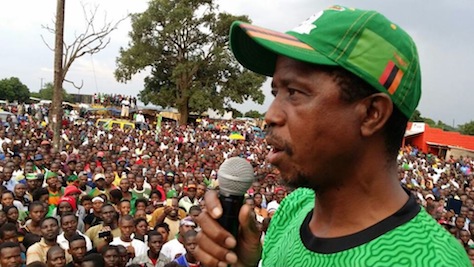When Michael Sata rose to power as Zambia’s president in 2011, he did so after vanquishing a political party, the Movement for Multi-party Democracy (MMD), that had dominated Zambian politics for two decades.![]()
The MMD, in turn, wrested power in 1991 from the United National Independence Party (UNIP), which controlled Zambia between 1964 and 1991 under its first post-independence, long-serving president Kenneth Kaunda (who is still alive today at age 91 and remains a relevant figure in Zambian politics).
So when Sata died last October, it wasn’t immediately clear that his ruling Patriotic Front (PF) would necessarily retain power in the by-election that’s being held today, and the PF candidate, justice and defense minister Edgar Lungu, is not a lock to win the Zambian presidency. Hakainde Hichilema, the candidate of the United Party for National Development (UPND), a businessman who is waging his fourth consecutive presidential bid in nine years, is presenting Lungu a strong challenge — so much so that Hichilema (pictured above) has an outside chance of winning.
* * * * *
RELATED: Sata’s death gives Zambia a white president in Guy Scott
* * * * *
While many countries in sub-Saharan Africa have a growing record of decades of democratic practice, Zambia is special insofar as it has moved beyond one-party politics. Though South Africa has held regular elections since 1994, the ruling African National Congress (ANC) easily won an absolute majority and the South African presidency under Nelson Mandela, Thabo Mbeki and now, Jacob Zuma. The same dynamic applies in Namibia, Botswana and Mozambique, where Filipe Nyusi was inaugurated just last week. In all four countries (and many others across the continent), the dominant political party remains, in essence, an evolved version of the country’s colonial-era independence movement.
What makes Zambia unique is that its post-colonial independence movement, UNIP, lost its grip on power a quarter-century ago. What’s emerged isn’t necessarily the left/right political contests that Western and European democracies know, but a personality-driven political marketplace. Nevertheless, Zambian elections have become every bit as competitive as campaign season in the United States or Italy or Australia. In the last four presidential votes, the winning margin was within single digits on three occasions and, on the fourth, the winning margin was just 13.6%. That’s a far cry from the three-to-one margins that the ANC routinely notches in South Africa’s national elections.
Though it’s just a country of 14.5 million people, that dynamic makes Zambia a potential bellwether for the future of democratic politics in southern Africa. Despite growing strides in democracy, the continent has seen just a handful of countries (e.g., Ghana, Mali, Senegal, Malawi) that have held elections resulting in multiple peaceful transfers of power from one party or movement to another. So what’s happening today in Zambia may be prologue for Mozambique and other countries in southern and, indeed, all of Africa.
Hichilema benefits from the same thing that the MMD did in 1991 (when Frederick Chiluba ousted Kaunda) and that Sata did in 2008 (when he ousted the MMD’s Rupiah Banda) — as an outsider, Hichilema is most credibly placed to challenge decades of Zambian governance as insufficient to lift many Zambians out of poverty. In particular, he has pledged to run a more business-friendly government than Sata, who often veered into populist rhetoric and who won election in 2011 on an anti-Chinese platform.
Foreign investment in Zambia is dominated by Chinese business, so much so that Mandarin language training is becoming widespread in the country, though many Zambians believe that Chinese investors exploit Zambian workers through low wages and poor treatment. While the Sata administration’s actions were often friendlier to Chinese investors than Sata’s words, he nevertheless introduced a 2014 measure raising royalties on open-pit copper mines from 6% to 20%, a rate increase that takes effect this month. Though it has alienated foreign investors and other players in the mining industry, the rationale was to help offset the budget deficits that Sata incurred to spend more heavily on infrastructure and rising public-sector wages. Hichilema, for his part, has promised to repeal the tax increase, at a time when copper prices are in decline worldwide.
Hichilema’s opponents both emerged from hugely divided parties.
Lungu (pictured above) only won the PF’s nomination after a bruising battle with incumbent acting president Guy Scott, who was elected vice president alongside Sata in 2011 and who now serves as sub-Saharan Africa’s only white president. He’s barred from contesting the presidency because his Scottish parents were not born in Zambia, but that didn’t stop him from trying to deny Lungu the nomination. One of the ruling party’s MPs, Sylvia Masebo, defected to Hichilema and argued that Lungu’s health is too weak — not a small concern for a country where two presidents have died in office in the last decade.
Meanwhile, the MMD remains divided after its tumble from power four years ago. Nevers Mumba, an evangelical minister-turned-politician who served briefly as vice president in the early 2000s, won the MMD leadership in 2012. But many of the MMD’s members are said to be leaning toward Hichilema, who quickly emerged as the chief opposition candidate to Lungu with a spirited campaign at the end of 2014.
That doesn’t mean Hichilema is necessarily a favorite. Despite the PF’s infighting, Lungu will benefit from Sata’s popularity and the sense, nurtured by Lungu, Scott and other leading PF figures, that Zambians owe it to Sata to allow his administration a full term to see through his administration’s measures. Either way, the winner of today’s presidential by-election will face voters again in 2016.
Kaunda’s son, Tilyenji Kaunda, is contesting the race himself as the candidate of the UNIP, which supported Hichilema in 2006 and the MMD’s candidate, Banda, in 2008.

